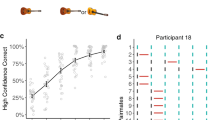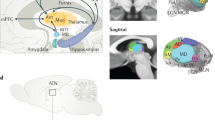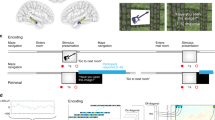Abstract
Recent models of hippocampal function emphasize the potential role of this brain structure in encoding and retrieving sequences of events that compose episodic memories. Here we show that hippocampal lesions produce a severe and selective impairment in the capacity of rats to remember the sequential ordering of a series of odors, despite an intact capacity to recognize odors that recently occurred. These findings support the hypothesis that hippocampal networks mediate associations between sequential events that constitute elements of an episodic memory.
This is a preview of subscription content, access via your institution
Access options
Subscribe to this journal
Receive 12 print issues and online access
$209.00 per year
only $17.42 per issue
Buy this article
- Purchase on Springer Link
- Instant access to full article PDF
Prices may be subject to local taxes which are calculated during checkout





Similar content being viewed by others
References
Vargha-Khadem, F. et al. Differential effects of early hippocampal pathology on episodic and semantic memory. Science 277, 376–380 (1997).
Tulving, E. & Markowitsch, H. J. Episodic and declarative memory: role of the hippocampus. Hippocampus 8, 198–204 (1998).
Mishkin, M., Suzuki, W. A., Gadian, D. G. & Vargha-Khadem, F. Hierarchical organization of cognitive memory. Phil. Trans. R. Soc. Lond. B Biol. Sci. 352, 1461–1467 (1997).
Levy, W. B. A sequence predicting CA3 is a flexible associator that learns and uses context to solve hippocampal-like tasks. Hippocampus 6, 579–590 (1996).
Sohal, V.S. & Hasselmo, M.E. Changes in GABAB modulation during a theta cycle may be analogous to the fall of temperature during annealing. Neural Comput. 10, 889–902 (1998).
Lisman, J. E. Relating hippocampal circuitry to function: recall of memory sequences by reciprocal dentate–CA3 interactions. Neuron 22, 233–242 (1999).
Wallenstein, G. V., Eichenbaum, H. & Hasselmo, M. E. The hippocampus as an associator of discontiguous events. Trends Neurosci. 21, 317–323 (1998).
Kesner, R. P. & Novak, J. M. Serial position curve in rats: role of the dorsal hippocampus. Science 218, 173–175 (1982).
Chiba, A. A., Kesner, R. P. & Reynolds, A. M. Memory for spatial location as a function of temporal lag in rats: role of hippocampus and medial prefrontal cortex. Behav. Neural Biol. 61, 123–131 (1994).
Eichenbaum, H., Dudchenko, P. A., Wood, E. R., Shapiro, M. L. & Tanila, H. The hippocampus, memory, and place cells: is it spatial memory or a memory space? Neuron 23, 209–226 (1999).
Rawlins, J. N. P. Associations across time: the hippocampus as a temporary memory store. Behav. Brain Sci. 8, 479–496 (1985).
Zola-Morgan, S., Squire, L. R. & Ramus, S. J. Severity of memory impairment in monkeys as a function of locus and extent of damage within the medial temporal lobe memory system. Hippocampus 4, 483–495 (1994).
Murray, E. A. What have ablation studies told us about the neural substrates of stimulus memory? Semin. Neurosci. 8, 13–22 (1996).
Murray, E. A. & Mishkin, M. Object recognition and location memory in monkeys with excitotoxic lesions of the amygdala and hippocampus. J. Neurosci. 18, 6568–6582 (1998).
Dudchenko, P. A., Wood, E. R. & Eichenbaum, H. Neurotoxic hippocampal lesions have no effect on odor span and little effect on odor recognition memory but produce significant impairments on spatial span, recognition, and alternation. J. Neurosci. 20, 2964–2977 (2000).
Aggleton, J. P. & Brown, M. W. Episodic memory, amnesia, and the hippocampal-anterior thalamic axis. Behav. Brain Sci. 22, 425–444; discussion 444–489 (1999).
Eichenbaum, H., Otto, T. & Cohen, N. J. Two functional components of the hippocampal memory system. Behav. Brain Sci. 17, 449–472; discussion 472–518 (1994).
Brown, M. W. & Aggleton, J.P. Recognition memory: what are the roles of the perirhinal cortex and hippocampus? Nat. Rev. Neurosci. 2, 51–61 (2001).
Murray, E. A. & Bussey, T. J. Perceptual-mnemonic functions of the perirhinal cortex. Trends Cogn. Sci. 3, 142–151 (1999).
Gaffan, D. Dissociated effects of perirhinal cortex ablation, fornix transection and amygdalectomy: evidence for multiple memory systems in the primate temporal lobe. Exp. Brain Res. 99, 411–422 (1994).
Mishkin, M. Memory in monkeys severely impaired by combined but not separate removal of the amygdala and hippocampus. Nature 273, 297–298 (1978).
Zola, S. M. et al. Impaired recognition memory in monkeys after damage limited to the hippocampal region. J. Neurosci. 20, 451–463 (2000).
Mumby, D.G. Perspectives on object-recognition memory following hippocampal damage: lessons from studies on rats. Behav. Brain Res. 127, 159–181 (2001).
Gaffan, D. Scene-specific memory for objects: a model of episodic memory impairment in monkeys with fornix transection. J. Cogn. Neurosci. 6, 305–320 (1994).
Clayton, N. S. & Dickinson, A. Episodic-like memory during cache recovery by scrub jays. Nature 395, 272–274 (1998).
Treves, A. & Rolls, E. T. Computational analysis of the role of the hippocampus in memory. Hippocampus 4, 374–391 (1994).
Kesner, R. P. in Neurobiology of Comparative Cognition (eds. Kesner, R. P. & Olton, D. S.) 179–204 (Lawrence Erlbaum, Mahwah, New Jersey, 1990).
Shapiro, M. L. & Olton, D. S. in Memory Systems (eds. Schacter, D. L. & Tulving, E.) 87–117 (MIT Press, Cambridge, Massachusetts, 1994).
Bunsey, M. & Eichenbaum, H. Conservation of hippocampal memory function in rats and humans. Nature 379, 255–257 (1996).
Dusek, J. A. & Eichenbaum, H. The hippocampus and memory for orderly stimulus relations. Proc. Natl. Acad. Sci. USA 94, 7109–7114 (1997).
Jarrard, L. E. in The Hippocampus Vol. 4 (eds. Isaacson, R. L. & Pribram, K. H.) 93–126 (Plenum, New York, 1986).
Swanson, L. W. Brain Maps: Structure of the Rat Brain Slides 32, 37 & 39 (Elsevier, Amsterdam, 1992).
Acknowledgements
We thank S. Rubin, J. Tourigny, S. Wright, L. Griffith, A. Cahill and A. Ceriales for help with behavioral testing and histological work. Supported by NIMH MH52090 (H.B.E.), NIA AG09973 (H.B.E.), and NSERC (N.J.F.).
Author information
Authors and Affiliations
Corresponding author
Ethics declarations
Competing interests
The authors declare no competing financial interests.
Rights and permissions
About this article
Cite this article
Fortin, N., Agster, K. & Eichenbaum, H. Critical role of the hippocampus in memory for sequences of events. Nat Neurosci 5, 458–462 (2002). https://doi.org/10.1038/nn834
Received:
Accepted:
Published:
Issue Date:
DOI: https://doi.org/10.1038/nn834
This article is cited by
-
New algorithm using an adaptive level set model applied to hippocampus segmentation and volume calculation in MRI images
Multimedia Tools and Applications (2024)
-
Dynamic and stable hippocampal representations of social identity and reward expectation support associative social memory in male mice
Nature Communications (2023)
-
Altered functional connectivity of the hippocampus with the sensorimotor cortex induced by long-term experience of virtual hand illusion
Virtual Reality (2023)
-
Thinking about order: a review of common processing of magnitude and learned orders in animals
Animal Cognition (2023)
-
Hippocampal ensembles represent sequential relationships among an extended sequence of nonspatial events
Nature Communications (2022)



